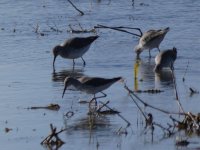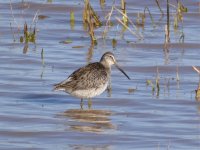In the field, the legs on all the bird were a dull yellow, so I think it is far more likely that, if the front bird is a stilt sand, the rest also are. I have a fair bit of experience with dunlin in the UK, and all the birds in that pic seemed larger than I'd expect dunlin to be? If stilt sand are dunlin sized, then I'd say they seemed larger than stilt sand too. Still, with that downcurved bill, I don't know what else they could be?
For comparison, do you agree the other pic is a dowitcher? I still have a lot to learn with NAmerican sandpipers!






